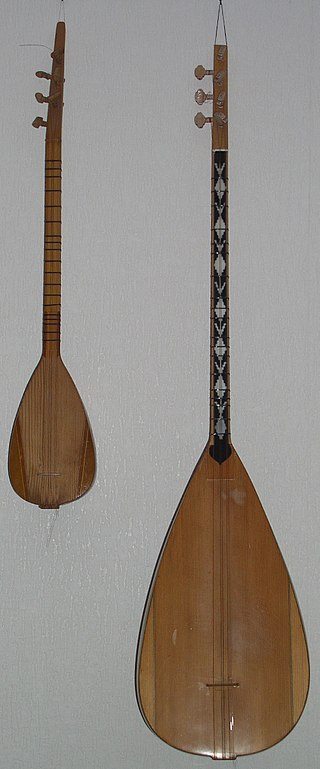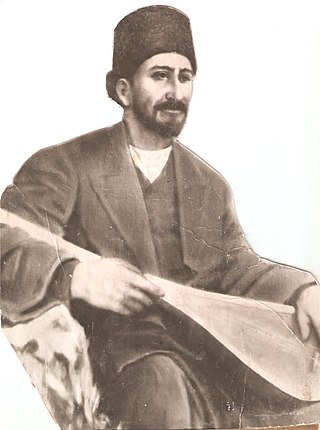Related Research Articles

The bağlama or saz is a family of plucked string instruments and long-necked lutes used in Ottoman classical music, Turkish folk music, Turkish Arabesque music, Azerbaijani music, Bosnian music (Sevdalinka), Kurdish music, and Armenian music. It is played in several regions in the world such as Europe, Asia, Black Sea, Caucasus regions and many countries including Syria, Iraq, Iran and Bosnia and Herzegovina. It is commonly used by the ashiks.

Azerbaijani music is the musical tradition of the Azerbaijani people from Azerbaijan Republic. Azerbaijani music has evolved under the badge of monody, producing rhythmically diverse melodies. Music from Azerbaijan has a branch mode system, where chromatisation of major and minor scales is of great importance.

The Book of Dede Korkut or Book of Korkut Ata is the most famous among the dastans or epic stories of the Oghuz Turks. The stories carry morals and values significant to the social lifestyle of the nomadic Turkic peoples and their pre-Islamic beliefs. The book's mythic narrative is part of the cultural heritage of the peoples of Oghuz origin, mainly of Azerbaijan, Turkey and Turkmenistan. Only two manuscripts of the text, one in the Vatican and one in Dresden, Germany. were known before a third manuscript was discovered in a private collection in Gonbad-e Kavus, Iran, in 2018.

An ashik or ashugh is traditionally a singer-poet and bard who accompanies his song—be it a dastan or a shorter original composition—with a long-necked lute in Azerbaijani culture, including Turkish and South Azerbaijani and non-Turkic cultures of South Caucasus. In Azerbaijan, the modern ashik is a professional musician who usually serves an apprenticeship, masters playing the bağlama, and builds up a varied but individual repertoire of Turkic folk songs.

Azerbaijani dances are traditional dances developed and performed in the Republic of Azerbaijan. These dances are known for their quick tempo and the dancers' traditional clothing.
Sari Gelin or Sari Aghjik is the name for a number of folk songs popular among the people of Iran, the southern Caucasus and in eastern Anatolia in present-day Turkey. All versions of the song use the same melody and are written in the Bayati makam or mode, but are sung with different lyrics. The consensus about its country of origin is contested.

Ashig Alasgar was an Azerbaijani mystic troubadour (Ashik) and highly regarded poet of Azerbaijani folk songs. He was born in the village of Aghkilsa in the Goycha District of the Erivan Khanate.
Bayat may refer to:

Zulfugar bey Abdulhuseyn oghlu Hajibeyov was an Azerbaijani composer and a member of a family noted for its musical talents. He was one of the founders of the Azerbaijan Music Comedy Theater.

The art of Azerbaijani Ashiqs combines poetry, storytelling, dance, and vocal and instrumental music into traditional performance art. This art is one of the symbols of Azerbaijani culture and considered an emblem of national identity and the guardian of Azerbaijani language, literature and music.
Azerbaijani folklore is the folk tradition of Azerbaijani people.

Ashiq Qarib is an anonymous romantic dastan, composed not earlier than the 16—17th centuries and popular in Transcaucasia and Central Asia. The verses, which are incorporated into the prose, are ascribed to the eponymous hero, a wandering Ashik who began his journeys with worldly love and attains wisdom by travelling and learning then achieving sainthood. The original Azerbaijani version was first recorded by Mikhail Lermontov in 1837 and was published in 1846. In 1915 Azerbaijani composer Zulfugar Hajibeyov wrote an opera Ashiq Qarib.

Opera in Azerbaijan has a history dating back to the 19th century Russian Empire.
Khasta Qasim – was an Iranian Azerbaijani poet of Azerbaijani literature. Khasta Qasim was one of the best Azerbaijani-language poets; he was also a mystic, ashik, and philosopher in the era of Afsharid Iran, popularly known as Dada and Gasim.

Turkish hikaye is a narrative genre, which is a mixture of prose and poetry. Prose, the dominant part is narrated by an ashik and is interspersed with poems sung by the same artist to the accompaniment of saz.
Bayaty-Shiraz is a musical modal system in traditional mugham music.
Ashiq Peri was a 19th-century ashiq regarded as the first prominent female Azerbaijani ashiq. Her poetry primarily consisted of verbal poetic duels, where she used various folk forms in Azerbaijani. Born in 1811 in the village of Maralyan in the Karabakh Khanate, she began writing poetry as a child and later moved to Shusha, the capital of the Karabakh Khanate. She often participated in local poetry contests, competing against and defeating her male counterparts, and eventually becoming the first renowned female ashiq in the region. She died young under unknown circumstances.

Armenian-Azerbaijani cultural relations are relations between two ethnic groups in terms of their language and culture.

"Shah Ismayil" is an Azerbaijani love dastan. There are collected up to 10 versions. According to some researchers, the dastan is associated with the name of Shah Ismail I, according to others - with the name of Shah Ismail II.
Zarnigar Derbentli is an Azerbaijani female ashiq and one of the prominent representatives of the female ashiq school of Azerbaijan in the 18th - 19th centuries.
References
- 1 2 Anna C. Oldfield. Azerbaijani Women Poet-minstrels: Women Ashiqs from the Eighteenth Century to the Present. Edwin Mellen Press, 2008. P. 60.